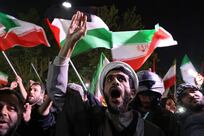A few weeks ago, Lionel Shriver, a white female writer of some repute, took to the stage of a literary festival in Brisbane. She wore a sombrero and proceeded to engage in a spirited if scathingly dismissive diatribe on how everyone (read: white) had the right to write about anything (read: about everyone who isn’t white).
In simple terms, Shriver was defending the status quo, in which white authors can take on just about anything as their subject, their uncontroverted brilliance dispelling any concerns of identity and context.
Shriver’s argument was a chastisement to all the non-white “others” but it has particular relevance to writing about Muslim women, arguably the most “other” in a world where being white and western defines belonging and confers voice.
One white saviour author who has taken on being “a voice for Middle Eastern women” is the author Jean Sasson of the Princess trilogy. The young Sasson was working as an administrator in Saudi Arabia when she met the woman she dubs Princess Sultana “who would change [my] life in the most profound manner”, and whose life of apparent oppression and abuse Sasson would document for the world.
Any Muslim woman who has read Princess will recognise the breathless sensationalism Sasson employed to frame her saga of silence and repression in the exotic Orient. All the usual caricatures are present: a wealthy but wronged heroine rendered mute by her culture, saved from obscurity by the chutzpah of the liberated white secretary who becomes her saviour. If Sultana bears the burden of the singularly demonic Arab man, Sasson takes her story and sets it free, the one-dimensional “barbarism” of Muslim lands laid bare by the intrepid white woman committed to female liberation.
Princess was first published in March 2001, but it was not the first book to take on the task of “explaining” what it views as the helpless lives of voiceless Muslim women. Six years earlier, the author Geraldine Brooks, who had been a Middle East correspondent for two years, wrote Nine Parts of Desire.
In that book, Brooks pinned the female oppression she witnessed to Islam, a feat whose genesis can easily be traced to her orientalist forebears. The enlightened goodness of colonial endeavour, as we know, depended on it being sold as an emancipation of women of the exotic but brutish “East”.
No one bothered with the creepy likeness that these white saviour memoirs of the neocolonial age had with the writings of white women orientalists of the past, Gertrude Bell and Freyja Stark among them. Unbothered by these histories, several white women authors, some adding a few refinements to Sasson’s sometimes pulp-fiction style, took on (again) documenting the supposedly tragic and mute existence of the Muslim woman.
Like Princess, the titles and covers beckon readers with a promised foray into forbidden worlds; Deborah Rodriguez takes readers into the Kabul Beauty School, Gayle Tzemach Lemmon offers a foray into the The Dressmaker of Khair Khana, and Jenny Nordberg an exploration into The Underground Girls of Kabul. All of them capitalise on the tried and true commercial formula availed by Sasson, a tale of repression in which Muslim women await saving or their stories await telling by their white, western saviours.
The white woman telling the story is audible, visible and courageous; she is the heroine of the tale. In a clever bait and switch, their story becomes her story; in the guise of a valiant rescue from invisibility, the women whose stories are the subjects of these books are obscured further. This second funeral, sold as a resurrection born of some genuine universal sisterhood, is not simply a commercial success, but also a strategic one.
In painting entire cultures as reprehensible, millions of men as brutes and millions of women as awaiting rescue, a new era of western imperialism is rendered justifiable. At its heart are women like Sasson, their stories, the soft propaganda that justifies the bombs and interventions.
This architecture of appropriation, through which Muslim women’s stories are taken and told by western women, is not solely erected on western opportunism alone. It relies also on cultural understandings of the public and the private, the dominance of the West in the global literary sphere and reticence towards confronting uncomfortable truths within the Muslim world itself.
Muslim women are raised within cultural ecosystems that frown on the public discussion and dissemination of private truths. This reverence for the sanctity of the private sphere provides western interlocutors, particularly women, a window of opportunity. If Muslim women aren’t telling their own stories, someone else will tell them.
When stories are told by others, the power resides with them rather than in those to whom these stories belong. It is the storytellers’ prejudices and precepts that will frame the narrative; the reduction of the brown man to the grunting, sexually insatiable brute, and the brown woman to the ever-suffering, eternally silent victim.
It is also true that it is largely western narratives that dominate the global literary sphere. While Sasson may not be venerated as a literary great, it is true that books like the Princess series are given little scrutiny in a world where voices just like hers dominate. The lack of critique imposes a cost: in essence a reduction of Muslim women to the white and western world’s rescue project and of Muslim men to the terrorists of the world.
There is an osmotic quality to these preconceptions; the good and evil binaries easily transmuted into human rights campaigns and other transnational conversations. The stories and those who tell them have power beyond the western book-buying public, influencing many more than the American housewife looking for solace in the greater sorrows of Sasson’s Sultana.
It must also be understood that the popularity of these books, their easy acceptance as the whole truth, relies on the fact that they are not entirely false. It is in fact the kernels of truth sandwiched between sensationalised mischaracterisations that are crucial to the architecture of appropriation and to stealing stories.
It is true that some women in Saudi Arabia are victims of domestic violence and that women are prohibited from driving. It is also true that in many Muslim countries women face laws that do not protect their rights, that they cannot obtain divorces with ease, that polygamy remains a threat to the integrity of their families and childlessness a threat to their very existence.
The worst response to any stereotype, to any magnification of one or another social ill, is the insistence that none exists, and yet this is precisely the trap that captures almost all retorts made by Muslim men and women to the stereotypes of the brutes and the brutalised.
To say that not a single Muslim or Arab man is a brute and that no women are ever brutalised is not an adequate nor a convincing rebuttal; it is, however, proof of being in denial. Contesting the truth of stories told by others requires telling complex stories of their own, not denying completely the need or possibility for storytelling at all.
Rafia Zakaria is the author of The Upstairs Wife: An Intimate History of Pakistan





